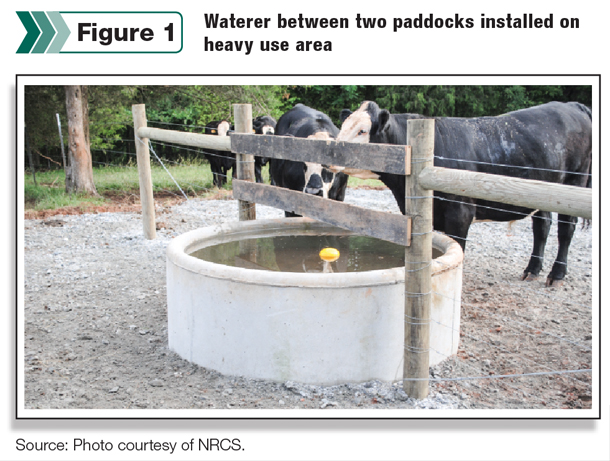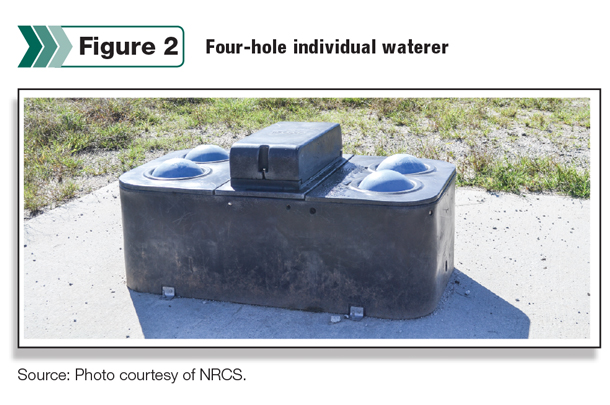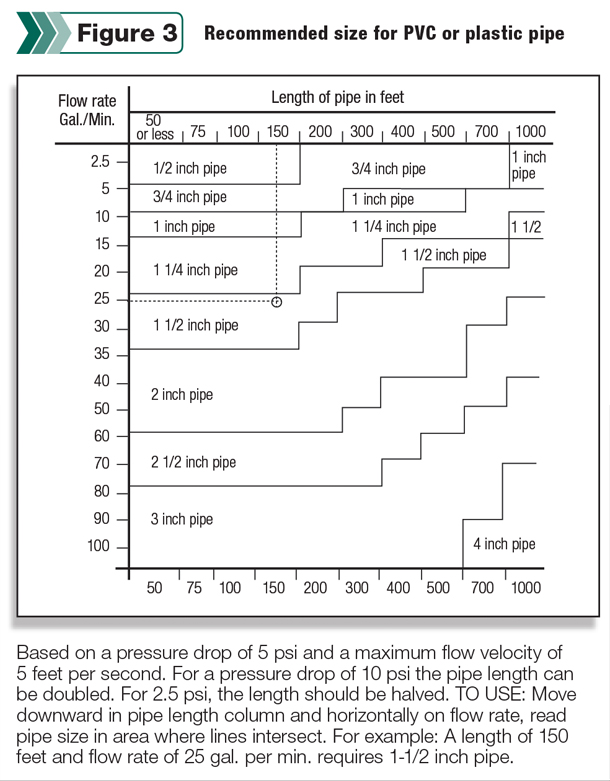One of the challenges of designing a rotational grazing system is providing an abundant supply of clean drinking water to cattle located in multiple paddocks or pastures. The use of surface water (creeks and ponds) has multiple drawbacks.
Fencing across a creek is always a challenge because of storm flows damaging the fence and the fence preventing debris from flowing down the creek. Also, cattle tend to degrade the banks of the creek, increasing sediment loading and decreasing water quality.
Perhaps the biggest challenge is: There just aren’t enough creeks to go around when you are trying to supply multiple paddocks.
Mechanical watering systems have many advantages but also present some challenges of their own:
- They cost money to install and operate.
- Many times, there is no electricity available for pumping at remote locations.
- Cows tend to congregate around waterers, the waterers often leak, and cows spill water – all of which lead to a muddy area around many waterers.
Some of these challenges can be addressed and costs minimized by proper planning.
Reducing the number of waterers required
Placing a waterer through a fence enables one waterer to be used from two paddocks (Figure 1).

Care must be exercised to provide enough watering space for cows from each side of the fence. For individual waterers (Figure 2), it is recommended to have at least one cup or bowl for each 15 cows.

For a drinking tank, it is recommended to provide 1 foot of accessible tank perimeter per 10 cows. That means 1 foot per 10 head on each side of the fence for a split installation like Figure 1. Cows tend to drink as a group, so adequate access to the waterers is important.
Another option for reducing the number of waterers required is to place a waterer in a lane or a common area that can be accessed from a number of paddocks.
Availability of power
If electricity is unavailable at a remote site, water can be pumped by solar power. In general, solar pumps are most efficient when pumping from surface water or shallow groundwater (less than 50 feet deep). Pumping from deep groundwater requires more energy and considerably more investment in solar panels.
Due to the intermittent availability of solar power (nights and cloudy days), a solar-powered watering system requires considerable reserve storage, either in the waterer itself or in a tank that feeds the waterers. I would recommend two to three days of storage capacity.
A typical 1,000-pound cow would drink up to 18 gallons of water per day in hot weather but on rainy or cloudy days would drink considerably less, so I would use a figure of 12 gallons per head per day. This reserve storage could be in the drinkers, the storage tank or a combination of the two.
Stream crossings are still an option for livestock watering, although they have the drawbacks mentioned above.
Mud around waterers
“Heavy-use areas” (Figure 1) can be installed around waterers to minimize mud problems. Financial assistance may be available from the NRCS through the EQIP program. An excellent publication on these surfaces is available from the University of Kentucky (Using Geotextiles for Feeding Traffic Surfaces).
The principle of heavy-use area construction is to stabilize the soil underneath the top layer so that it does not move, settle and form mud holes.
By putting down a layer of geotech fabric, the rock placed on top of the fabric cannot move from side to side, and thus depressions (mud holes) are prevented from forming. Typically, this type of construction costs about half that of a concrete pad.
When choosing the site for waterers, it is wise to choose a site that is high and well drained. In addition, regular checking and maintenance of valves and pipes is important in preventing excess mud and wasted water. The stabilized area should extend at least 15 feet from the waterer for cows and 8 feet for goats or sheep.
The same strategy can be used to stabilize travel lanes to prevent erosion. Travel lanes should be fairly narrow (12 to 15 feet) and crowned in the center to promote drainage. Lanes should be fenced to force animals to stay on the stabilized area.
If they have a choice, they will go back and forth between muddy and stabilized areas, which can cause foot problems due to rocks being picked up by muddy feet.
Choice of drinker type
Individual drinkers, like the one shown in Figure 2, have the advantage of helping keep the water cooler and cleaner in hot weather, and they are virtually freeze-proof in cold weather (at least in the Southeast.)
Tank waterers (Figure 1), which can be made of galvanized steel, plastic or concrete, have the advantage of greater accessibility to a number of animals and more water storage in the waterer itself. Individual waterers must have water provided to them at all times because the water would be quickly depleted if the supply were cut off. That is especially a consideration when solar pumps are used to supply waterers.
Note that the concrete waterer in Figure 1 has the control valve mounted in the bottom middle of the tank. That protects it from both mechanical damage (cows rubbing against it or running into it) and freezing, and it eliminates many of the maintenance problems associated with top-mounted valves.
Sizing the supply system
Whether using solar or conventional electric power to pump water, it is important to size the pump and piping to deliver the maximum needed flow of water without excessive friction loss in the pipe. Three things potentially contribute to pressure drop in water pipes: the length of the pipe, the flow rate of water and the elevation change from one end to the other.
If we try to force too much water through a small pipe, friction loss will reduce the pressure at the waterer, reducing the flow rate and sometimes causing the valve to not operate properly. The supply system should be able to pump water needed for a day in about four hours, since cows tend to drink as a herd.
With a maximum rate of 18 gallons per day, 100 cows would need 1,800 gallons of water. To pump that in four hours, the flow rate would be 7.5 gallons per minute.
Figure 3 may be helpful in sizing the pipe needed to supply the waterer. In the above example, if the flow rate is 10 gallons per minute, and the watering site is 300 feet from the pump, a 1¼-inch PVC pipe would be needed to limit the pressure drop to 5 psi.

If sufficient pressure exists to allow 10 psi pressure drop, a 1-inch pipe would suffice.
The drinker valve should have at least 10 psi of pressure at all times to operate reliably. Also, remember that if you are pumping uphill, you will lose pressure as well.
For every 10 feet of elevation, the pressure drops (or increases if going downhill) by approximately 4.3 psi. The pump needs to be sized to deliver the needed flow rate at the total pressure it will be working against.
That pressure includes elevation change from the water level in the well or surface of a pond to the top of the storage tank, friction loss in the pipe and the operating pressure of the valve.
For long runs, and especially with large pipes, you may need to imbed any corners of the pipe in concrete to prevent movement of the pipe when water starts flowing. Repeated movement may cause cracking and leaking.
Sanitation
Waterer control valves should always be fitted with anti-siphoning devices. This prevents contaminated water from being sucked from the trough down into the well or water source when the pump shuts off. Also, waterers should be designed for ease of cleaning. The easier they are to clean, the more likely they are to be cleaned.
Using these principles will help you provide an abundant, reliable, clean water supply to your herd at a minimum cost. ![]()
John W. Worley is with J. Phil Campbell Research and Education Center - University of Georgia. Email John W. Worley.






